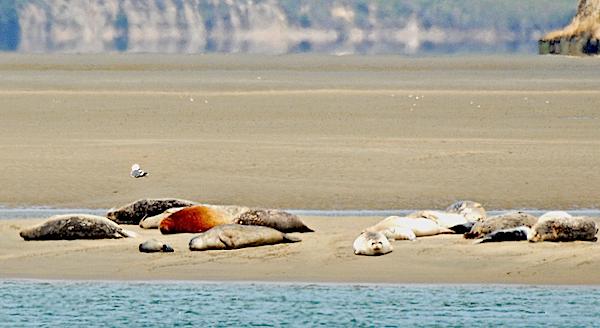
With harbor seals entering their pupping season, some areas of Point Reyes National Seashore will be off-limits to visitors/NPS-Jessica Weinberg McClosky
With pupping season arriving for harbor seals at Point Reyes National Seashore in California, some areas of the seashore will be off-limits to visitors for the next four months.
The closures take effect Sunday. They involve Drakes Estero and the westernmost point of Limantour Spit, seashore officials say. During this most sensitive time of year for the harbor seals, the National Park Service asks park visitors to help ensure a successful pupping season by avoiding disturbing seals.
Point Reyes National Seashore has one of the largest concentrations of breeding harbor seals on the California mainland. Resting and pupping harbor seals come onshore in various parts of the park, particularly in Tomales Bay, Tomales Point, Double Point, Drakes Estero, and Bolinas Lagoon. Each year, several thousand seals congregate within the seashore to give birth on the sand bars and remote beaches.
All recreational water access in Drakes Estero is closed during this season, as is access to the western-most point of Limantour Spit. The closure applies to kayaks, and canoes, and is applicable to surfers, windsurfers, paddle boards, abalone divers, recreational fishing, and other water sport users around harbor seal colonies in the area.
Hog Island in Tomales Bay is closed during this same time period for nesting and roosting seabirds, such as double-crested cormorants and brown pelicans. To ensure that harbor seals are not disturbed, visitors are asked to stay at least 100 yards (300 feet) away from resting seals. Visitors should never pick up a seal pup that may look abandoned. Although harbor seal pups may appear abandoned, they are most likely waiting for their mother to return.
Pups are about two feet long and weigh about 24 pounds and are weaned at 30 days after birth. If you are concerned about a particular seal, please contact park staff at one of the visitor centers.
Last year, more than 4,300 harbor seals were counted on the seashore, 1,250 of which were pups. The number of seals breeding at Point Reyes represents around 20 percent of the California mainland population estimate.
The seashore staff is conducting long-term monitoring to gain further scientific knowledge on this species and to guide management in their protection. Access to the east side of Hog Island in Tomales Bay is prohibited year round. Harbor seals haul out on the sand bar at Hog Island throughout the year but are most abundant during the winter when their preferred prey, Pacific herring, spawn in Tomales Bay. During the spring months, females with pups also haul out there.
A few species of seabirds roost on Hog Island, including brown pelicans and double-crested cormorants. Cormorants also have a couple of hundred nests in trees on the island in the spring and summer. They forage on various species of small schooling fish that congregate in Tomales Bay.
All of Hog Island is closed to all human activity from March 1 through June 30.



Add comment